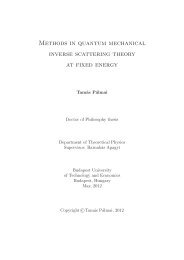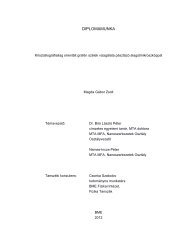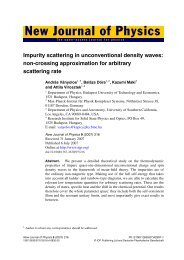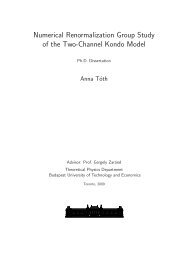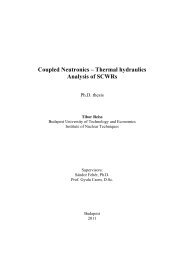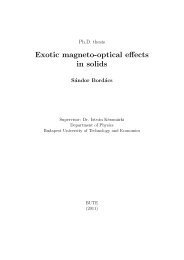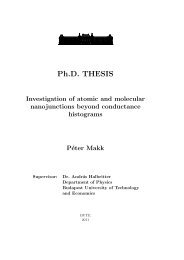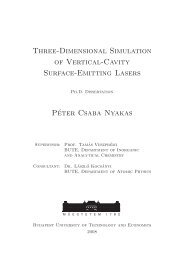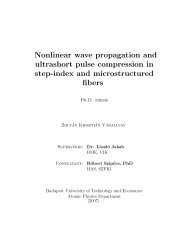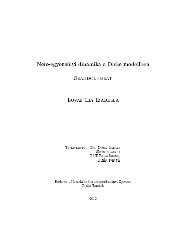Ph.D. THESIS Multipolar ordering in f-electron systems
Ph.D. THESIS Multipolar ordering in f-electron systems
Ph.D. THESIS Multipolar ordering in f-electron systems
Create successful ePaper yourself
Turn your PDF publications into a flip-book with our unique Google optimized e-Paper software.
Chapter 3 Octupolar Order<strong>in</strong>g of Γ 8 Ions 37<br />
Octupolar <strong>order<strong>in</strong>g</strong> is spontaneous symmetry break<strong>in</strong>g, and it is a way<br />
to break time reversal <strong>in</strong>variance without magnetic <strong>order<strong>in</strong>g</strong>. This raises a<br />
fundamental question. The application of an external magnetic field destroys<br />
time reversal <strong>in</strong>variance. Is spontaneous symmetry break<strong>in</strong>g by octupolar<br />
<strong>order<strong>in</strong>g</strong> possible <strong>in</strong> a f<strong>in</strong>ite magnetic field?<br />
The answer to the above question is delicate. Whether spontaneous symmetry<br />
break<strong>in</strong>g rema<strong>in</strong>s possible depends on the direction of the applied magnetic<br />
field. For fields po<strong>in</strong>t<strong>in</strong>g <strong>in</strong> high-symmetry directions, a second-order<br />
octupolar transition rema<strong>in</strong>s possible, or it may even split <strong>in</strong>to two consecutive<br />
transitions. For non-symmetric field directions, the phase transition<br />
is suppressed. We study this problem <strong>in</strong> the context of the ferro-octupolar<br />
model <strong>in</strong> Sections 3.3 and 3.4. The methods developed here are of importance<br />
for the latter Chapters as well. It is of general <strong>in</strong>terest to understand how<br />
the magnetic field <strong>in</strong>fluences different multipoles. It is possible to consider<br />
the problem from two angles. First, the field changes the symmetry of the<br />
problem and a new symmetry classification of the order parameters has to be<br />
used. Second, one may emphasize that different multipoles get coupled <strong>in</strong> the<br />
presence of an external field. We develop both po<strong>in</strong>ts of view <strong>in</strong> considerable<br />
detail.<br />
Most of the results described <strong>in</strong> this Chapter were published <strong>in</strong> [2]. The<br />
symmetry argument described <strong>in</strong> Section 3.4.2 was briefly discussed <strong>in</strong> [1].<br />
3.1 Octupolar Moments <strong>in</strong> the Γ 8 Quartet State<br />
The Γ 8 irreducible representation occurs twice <strong>in</strong> the splitt<strong>in</strong>g of the tenfold<br />
degenerate J = 9/2 manifold of Np 4+ free ion (Fig. 2.2). In what follows,<br />
we construct a lattice model <strong>in</strong> which each site carries the Γ 1 8 quartet of<br />
states. S<strong>in</strong>ce the Γ 8 irrep occurs twice, symmetry alone cannot tell us the<br />
basis functions. Their detailed form depends on the crystal field potential.<br />
However, for many aspects of the problem the specific form of the basis states<br />
is not essential, what matters is that they are Γ 8 basis states. For the sake of<br />
simplicity, we choose the Γ 8 eigenstates of a purely fourth-order cubic crystal<br />
field potential (<strong>in</strong> standard notations O4 0 + 5O4).<br />
4<br />
The four states represented <strong>in</strong> terms of the basis |J z 〉 of J = 9/2 are (the<br />
numerical coefficients are given <strong>in</strong> Appendix B):<br />
Γ 1 8 = 〉<br />
〉<br />
〉<br />
7<br />
α<br />
∣ + β<br />
∣<br />
2<br />
+ γ<br />
∣<br />
2<br />
2<br />
Γ 2 8 = 〉<br />
〉<br />
〉<br />
9<br />
1<br />
γ<br />
∣ + β<br />
∣ + α<br />
∣<br />
2 2<br />
2



